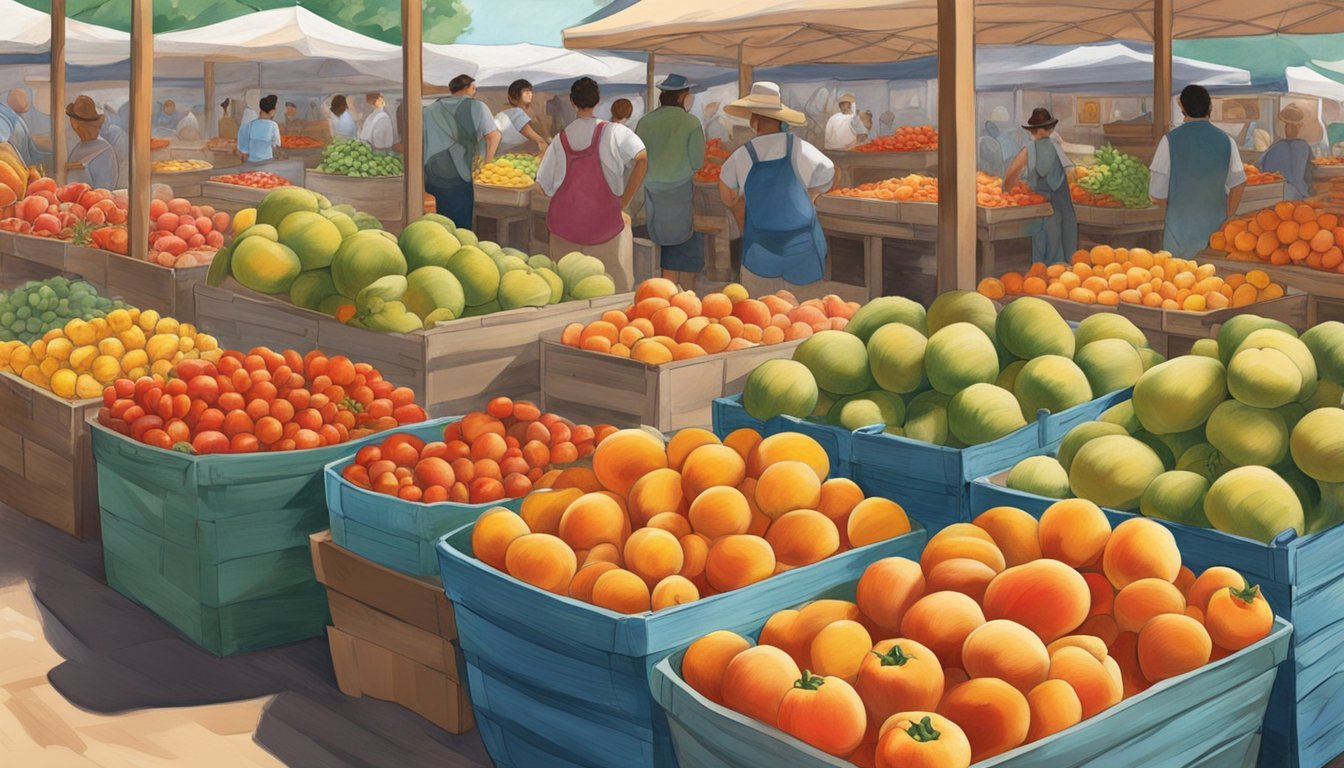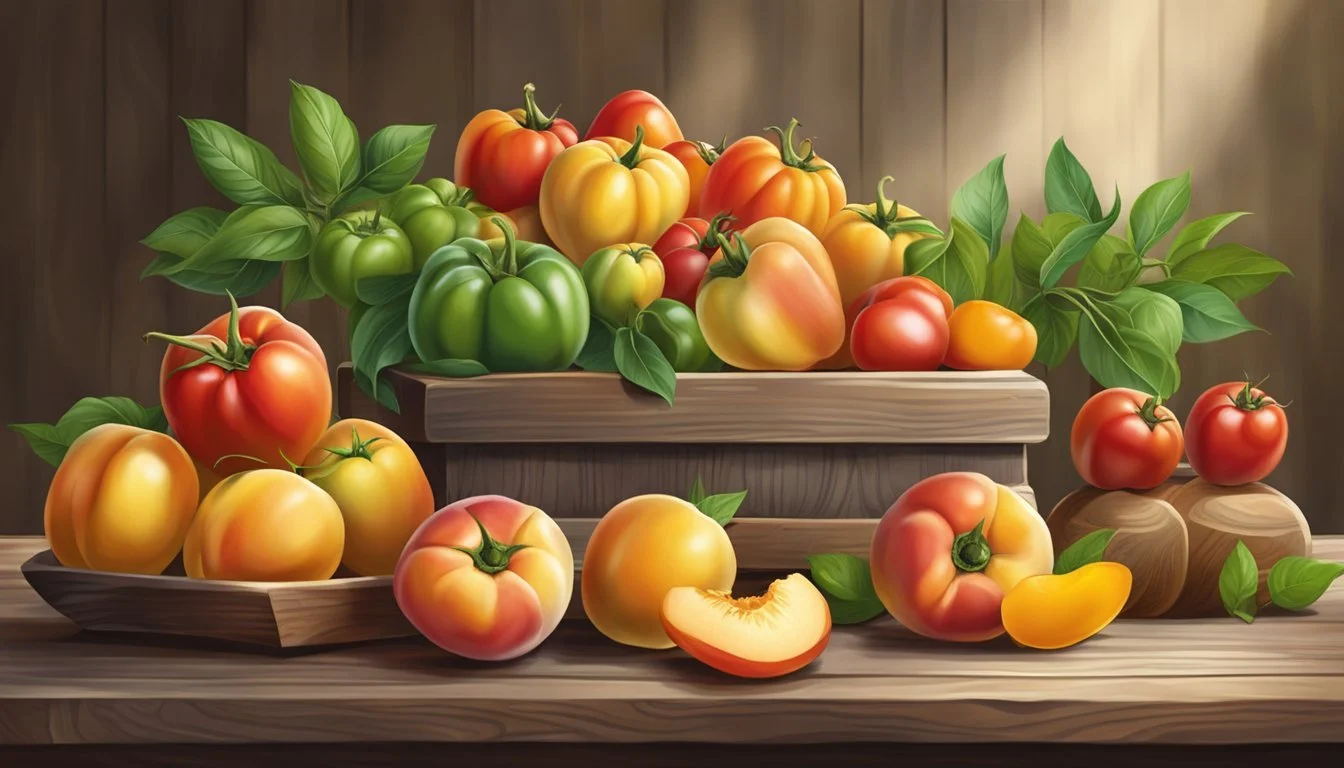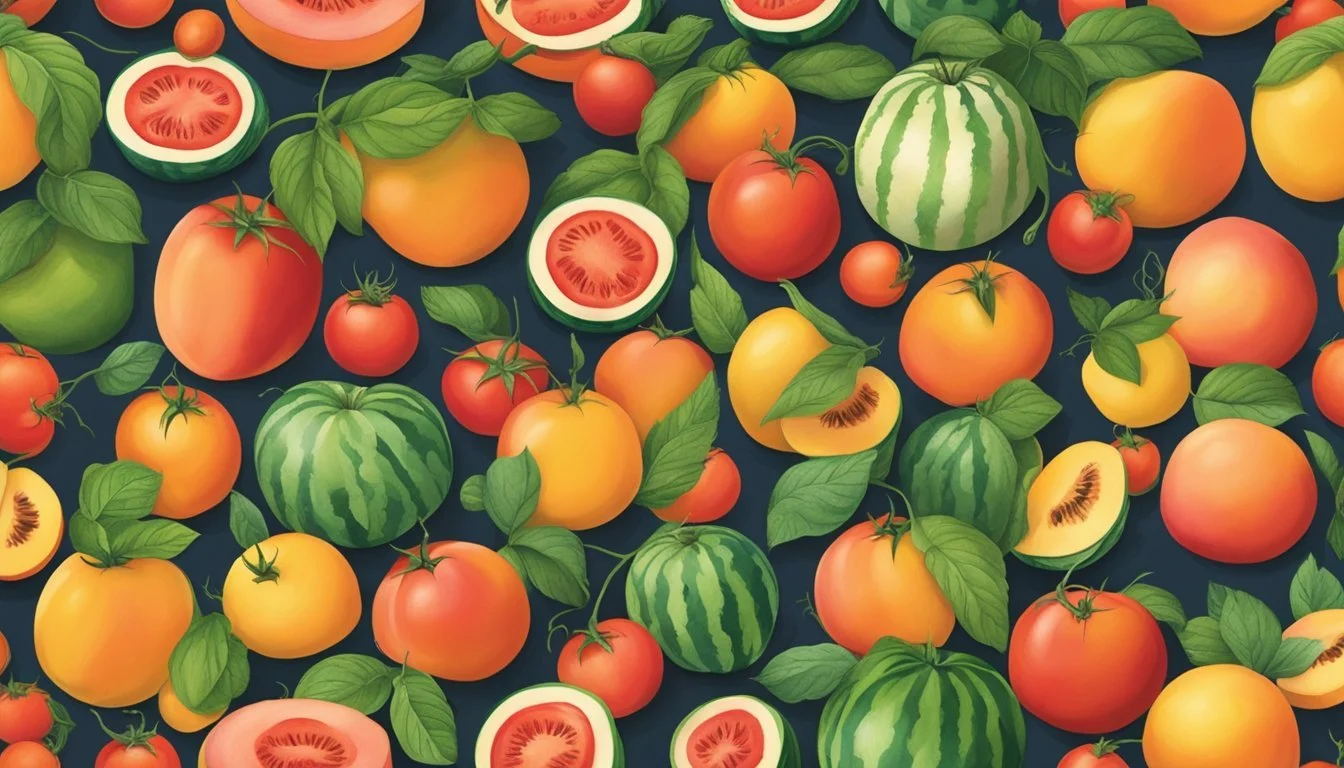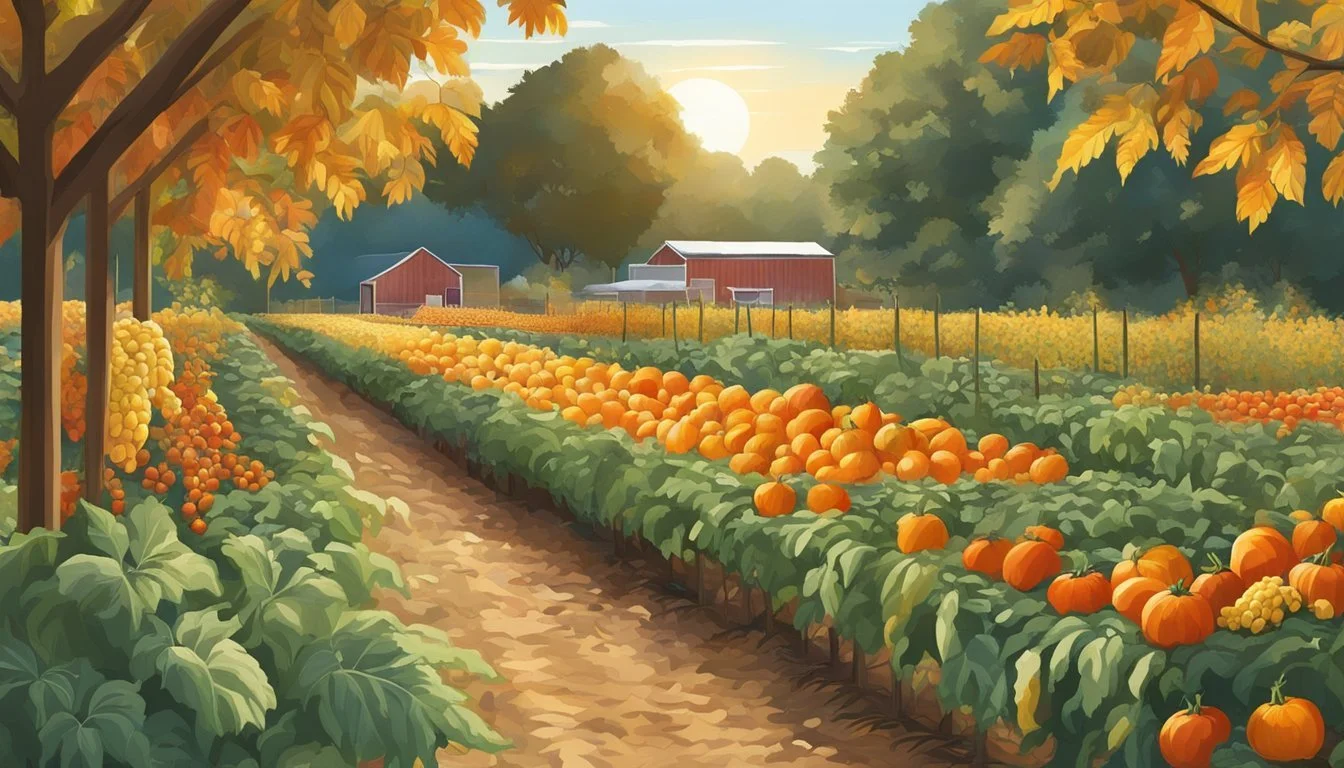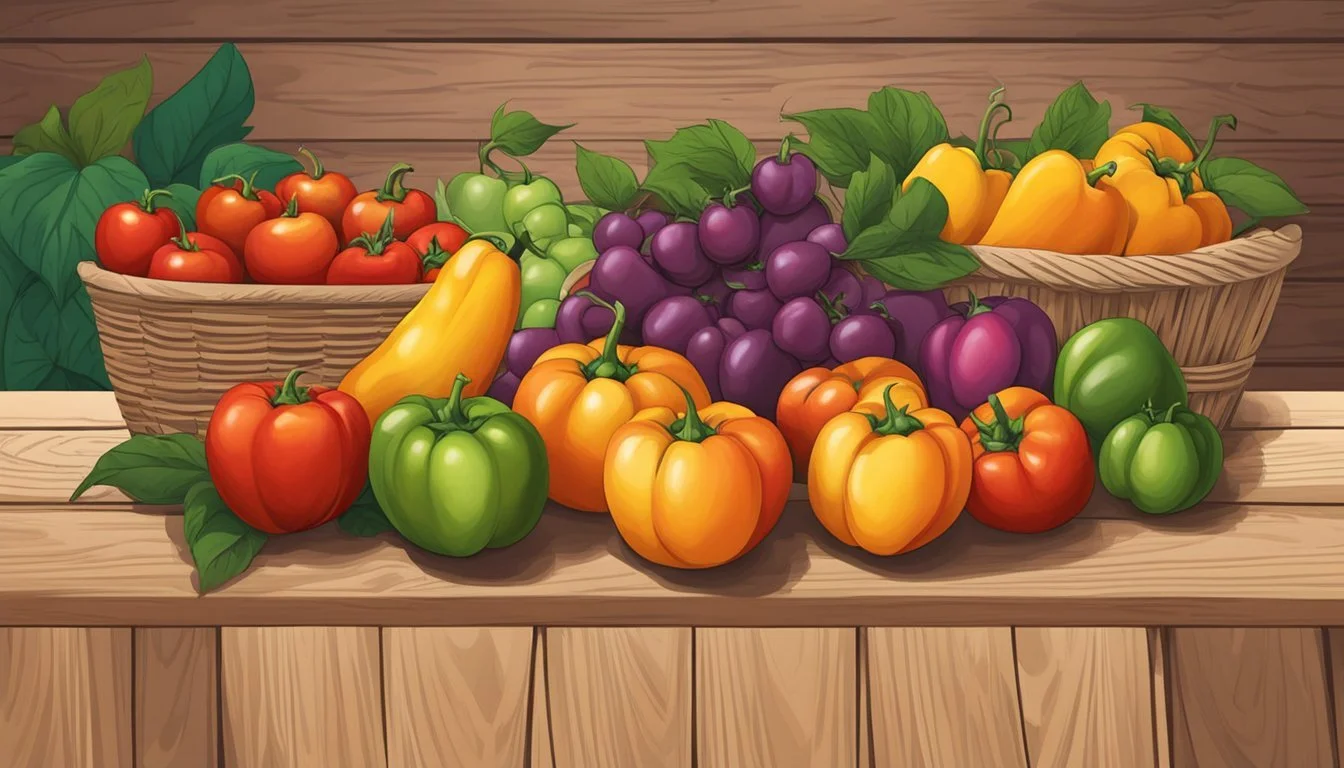Tennessee Seasonal Fruit & Vegetables in September
Your Fresh Produce Guide
This Article is Part of our Tennessee Seasonal Fruit & Veg Calendar
September marks a transitional period in Tennessee's agricultural calendar as the peak of summer gives way to the onset of fall. This month in Tennessee, the selection of seasonal fruits and vegetables includes the last of the ripe summer harvest as well as the first pickings of autumn's bounty. The temperate climate and fertile soil in the state allow for a wide array of produce to flourish.
During this time, farmers and gardeners across Tennessee harvest a variety of fruits that are at their peak flavor and nutritional content. Among these are late-season peaches and the tail end of blueberries, while apples begin to take center stage in orchards. Vegetables are equally diverse, with summer crops like tomatoes and green beans continuing to thrive, while pumpkins and winter squash signal the changing season.
Shoppers visiting local farmers markets or participating in community supported agriculture (CSA) programs can expect to find these seasonal offerings in abundance. By choosing local, in-season produce, consumers not only get the freshest flavors but also support Tennessee's agricultural community and sustainable food systems.
Overview of Tennessee's Seasonal Produce
In September, Tennessee showcases a variety of fruits and vegetables, thanks to its distinctive climate and varied hardiness zones. This diversity enables a rich harvest that is influenced by regional climatic conditions.
Climatic Influence on Harvest
Tennessee's climate significantly shapes its agricultural output. With a diverse climate ranging from humid subtropical to continental, one can expect variations in temperature and precipitation. This directly affects the seasonal availability of produce. In September, cooler temperatures in certain parts of Tennessee allow for the flourishing of crops that prefer a milder climate as summer transitions to fall.
Understanding Hardiness Zones
The concept of hardiness zones is integral to understanding what grows in Tennessee during different seasons. These zones, defined by the USDA, help determine the specific varieties of fruits and vegetables that can survive and thrive in the region. Tennessee is primarily split across zones 5 through 8, which means gardeners and farmers must select crops that can withstand the minimum temperatures of these areas.
Fruits in Season
September in Tennessee heralds the transition from summer to fall, reflecting a shift in the seasonal fruits available. Consumers can expect a diverse palette of flavors from the last blooms of summer berries to the burgeoning harvest of tree fruits.
Berries and Stone Fruits
In early September, berries such as blackberries (how long do blackberries last?) may still be found, although nearing the end of their season. Stone fruits like peaches, a summer favorite, become less common as the month progresses.
Berries: Limited availability of blackberries.
Stone Fruits: Peaches winding down.
Tree Fruits
Apples come into fuller force in September with a variety of types ripe for the picking. Pears also make a welcome entrance as they reach maturity during this month.
Apples: Multiple varieties ready for harvest.
Pears: Begin to peak in freshness.
Late Summer Varieties
While many summer fruits wane, plums and figs offer a burst of sweetness to the late summer seasonal selection. These fruits typically have a shorter window of peak availability, making them sought after in early autumn.
Plums: Sweet and juicy options available.
Figs: A unique, short-lived presence in the market.
Vegetables Ready for Harvest
In Tennessee, the range of the growing season allows for a bountiful September harvest. This period is characterized by a diversity of vegetables reaching maturity and ready for picking from various plant families.
Root Vegetables and Gourds
Root Vegetables: September in Tennessee is an excellent time for harvesting root vegetables.
Carrots: They should be firm, brightly colored, and of varying sizes.
Potatoes: Look for them to be well-sized and firm to the touch.
Gourds: The gourds family offers several ready-to-harvest options.
Pumpkins: When they display a deep, solid color and sound hollow when tapped, they are typically ready.
Squash: Includes varieties like butternut and acorn, which should feel heavy for their size and have a hard, tough exterior.
Leafy Greens and Legumes
Leafy Greens: These vegetables are often at their peak in early fall.
Kale: Look for dark, crisp leaves indicating freshness and full growth.
Lettuce: Should feature firm heads and vibrant leaves, free from browning edges.
Legumes: Such as beans, are also commonly harvested during this time.
Beans: Pods should be firm and snap readily when bent.
Nightshades and Cucurbits
Nightshades: This family includes some vegetables that are essential to the September harvest.
Tomatoes: They should have a uniform color and give slightly under pressure.
Peppers: Both bell and chili varieties are picked when they are firm and have a glossy exterior.
Cucurbits: Zucchini and eggplants (What wine goes well with eggplant?) fall into this category.
Zucchini: Ready when they are about 6 to 8 inches long and have a dark green skin.
Eggplants: Harvested when they have glossy, unblemished skins and a slight firmness when pressed.
Corn: Although not a nightshade or cucurbit, is worth mentioning as it's often harvested in September. Ears should have plump kernels and the silks should be brown and slightly sticky to the touch.
Selection and Storage Tips
When selecting Tennessee fruits and vegetables in September, one should focus on the indicators of peak ripeness and employ proper storage techniques to maintain quality and extend shelf life.
Identifying Peak Ripeness
Fruit:
Apples: Look for a firm texture and a vibrant, consistent color. A ripe apple should have a sweet aroma and the flesh should give slightly when pressed.
Pears: Press gently near the stem; if it yields slightly, the pear is ripe. The skin should be smooth and free of blemishes.
Vegetables:
Cauliflower: Choose heads that are creamy white, without any brown spots, and firm to the touch.
Bell Peppers: Opt for peppers with deep, vivid colors and taut, glossy skins. They should feel heavy for their size, indicating juiciness.
Proper Storage Techniques
Fruit:
Apples and Pears: Refrigerate in a crisper drawer, away from vegetables, as they emit ethylene gas which can speed up the ripening process of other produce.
Freezing: For long-term storage, both apples and pears can be sliced and frozen. To maintain flavor, blanching and a light sugar syrup can help preserve them.
Vegetables:
Cauliflower: Store in the refrigerator, loosely wrapped in plastic, and consume within a week for best flavor.
Bell Peppers: Keep in the vegetable drawer of the refrigerator; they can also be sliced and frozen without blanching for use in cooked dishes.
Using these specific tips will help ensure that the fruits and vegetables retain their optimal flavor, freshness, and nutritional value.
Health Benefits of Seasonal Eating
Eating with the seasons offers multiple health and environmental benefits. It supports nutritional intake from fresh produce when they are at their peak in flavor and abundance.
Nutritional Advantages
Seasonal eating enhances the nutritional value of one’s diet, as fruits and vegetables consumed during their appropriate seasons tend to contain more nutrients. For instance, local produce in Tennessee, such as tomatoes and peppers harvested in September, are likely to have higher levels of vitamins and antioxidants since they are picked at their optimal ripeness. They do not undergo long transit periods, which can cause nutrient degradation.
Vitamins: Seasonal fruits and vegetables provide a rich source of vitamins, like Vitamin C and A, which are crucial for immune health and vision.
Antioxidants: These compounds combat oxidative stress and may reduce the risk of chronic diseases. Seasonal berries and leafy greens are excellent sources of these beneficial components.
Environmental Impact
Choosing seasonal and local produce also diminishes the environmental impact linked to food transportation and storage. When consumers purchase fruits and vegetables from local Tennessee farms during their respective seasons, it means a reduction in the energy required to store and transport goods over great distances.
Reduced Carbon Footprint: Fewer transportation miles contribute to less fuel usage and, subsequently, lower carbon emissions.
Supports Local Economy: Buying seasonal items supports regional farmers and contributes to the local economy.
By highlighting the specific benefits of consuming nutrients from seasonal eating, one can appreciate not only the personal health gains but also understand how this practice encourages sustainability and supports the local agricultural community.
September Agricultural Events
In September, Tennessee celebrates the harvest season with a variety of agricultural events, attracting visitors to experience the state's bountiful produce firsthand.
Festivals and Markets
Tennessee State Fair: Taking place in Nashville, this annual event features agricultural exhibits, competitions, and an array of fresh produce from local farmers.
Farmers Markets: Across the state, farmers markets extend their offerings with September's harvest. Key markets include:
Nashville Farmers Market: A year-round marketplace with a special focus on September harvests.
Memphis Farmers Market: Showcases a rich selection of local fruits and vegetables ripe in September.
Farm Experiences
Pumpkin Patches and Corn Mazes: Farms transform their fields into family-friendly attractions. Notable destinations include:
Cedarwood Farms: Offering a pumpkin patch and corn maze, making it a perfect spot for families.
Lucky Ladd Farms: Features interactive experiences with a fall festive theme.
Pick-Your-Own Farms: Many farms open their orchards and fields for visitors to pick their own apples, a September staple.
Walden Pumpkin Farm: Invites guests to hand-pick pumpkins and enjoy hayrides.
Breeden's Orchard: Known for apple picking and local honey, a delight for visitors throughout September.
Preparing Tennessee Produce
When the vibrant bounty of Tennessee produce arrives in September, residents have a wealth of options for bringing the flavors of the season to their tables. They can enjoy the fresh taste of locally-grown vegetables and fruits through time-honored recipes or preserve their harvest for later enjoyment.
Simple and Traditional Recipes
Tennessee's September produce lends itself wonderfully to simple and traditional recipes. A classic salad might feature ripe tomatoes, crisp cucumbers (how long do cucumbers last?), and sweet corn, all tossed with a light vinaigrette. For heartier appetites, squash soups infused with herbs like thyme and sage make for a comforting meal as the evenings begin to cool.
Tomato Cucumber Salad
Ingredients: tomatoes, cucumbers, sweet corn, red onions, vinaigrette.
Dice the tomatoes and cucumbers, slice the onions, mix with corn, and dress with vinaigrette.
Butternut Squash Soup
Ingredients: butternut squash, vegetable stock, onion, garlic, thyme, sage, cream.
Sauté onions and garlic, add diced squash and stock, simmer, blend until smooth, stir in cream, and season with thyme and sage.
Preservation Methods
For those looking to savor the tastes of September long after the month has passed, preservation methods like freezing and canning are invaluable techniques. Many of Tennessee's fruits and vegetables can be stored through these methods, ensuring that the autumn harvest can be enjoyed well into winter.
Freezing Guidelines
Blanch vegetables before freezing to preserve color, texture, and flavor.
Slice fruits and lay them on a baking sheet to freeze individually before transferring to bags.
Canning Essentials
Use a water bath method for acidic foods like tomatoes and fruits.
For low-acid vegetables, a pressure canner is necessary to prevent spoilage.
With these strategies, not only does one appreciate the immediate pleasure of Tennessee's September produce, but they can also build a pantry that brings joy and nutrition throughout the year.
Challenges for Tennessee Farmers
In September, Tennessee farmers face a unique set of agricultural challenges as they transition from summer to fall. Efficient management of pests and diseases is crucial, and weather-related concerns become increasingly pertinent.
Pests and Disease Management
Farmers in Tennessee must remain vigilant against pests and diseases, especially in the early fall season. Crop rotation and judicious use of insecticides are strategies they employ to mitigate these issues.
Insects: The onset of cooler weather can lead to an increase in pest activity, as insects like aphids and mites seek to feed before the winter.
Disease: Warm, humid conditions may also foster fungal diseases, which can devastate fruit and vegetable crops if not properly managed.
Weather-Related Concerns
The weather in Tennessee's early fall can be particularly unpredictable, impacting agricultural productivity. Farmers confront the challenges head-on by monitoring forecasts and adapting their practices accordingly.
Seasonal Changes: As summer heat wanes, the first frosts of the season can arrive unexpectedly, potentially harming sensitive crops.
Weather Events: Sudden storms or extended rainfall can cause flooding and erosion, leading to crop loss and soil degradation.
Through meticulous planning and responsive strategies, Tennessee farmers navigate these September challenges with expertise.

